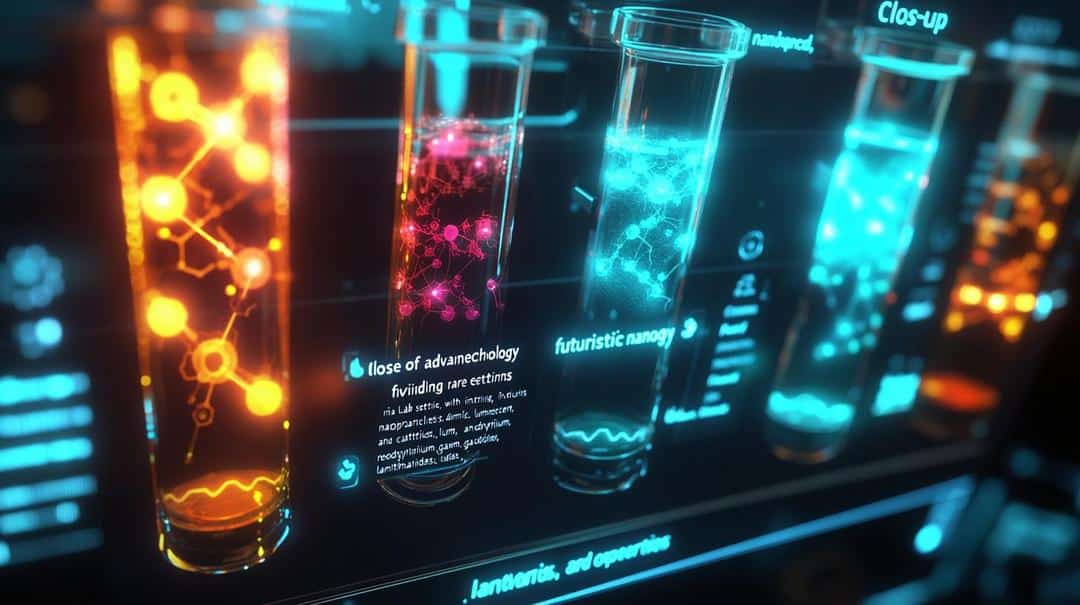Did you know that rare earth elements (REEs) are essential for much more than just your smartphone’s vibrant display? These metals are the unsung heroes of cutting-edge technology, and believe it or not, their roles shrink down to the nano level—literally! From enabling better electric vehicles to revolutionizing cancer treatment, rare earth nanotechnology is making things happen on a tiny scale with huge implications. If you’re curious about what makes these rare earth elements so special and how they intersect with nanotechnology, you’re in the right place. Stick around for some fascinating facts that could reshape industries as diverse as electronics, medicine, and renewable energy!
What's Inside
What is Rare Earth Nanotechnology?
Rare earth nanotechnology represents a cutting-edge field that harnesses the unique properties of rare earth elements (REEs) at the nanoscale. These elements—including neodymium, gadolinium, and various lanthanides—possess extraordinary characteristics that transform technological capabilities across multiple industries.
Key Characteristics of Rare Earth Nanomaterials
- Exceptional magnetic properties
- Enhanced luminescent capabilities
- Superior catalytic performance
- Unique optical and electronic behaviors
The strategic importance of rare earth elements cannot be overstated. As global technological demands increase, these materials become increasingly critical for advanced innovations. From electronics to medical technologies, rare earth nanomaterials are driving transformative breakthroughs that push the boundaries of what’s scientifically possible.
Rare Earth Nanotechnology in Electronics
Electronic devices have become increasingly dependent on rare earth nanomaterials. Yttrium-based nanomaterials, for instance, are revolutionizing data storage technologies by enabling faster and more energy-efficient hard drives.
Breakthrough Applications
- Permanent magnets in electronic components
- Phosphors in LED screens
- Advanced data storage solutions
- High-performance semiconductor materials
Current estimates suggest that over 60% of commercial electronics now incorporate rare earth elements in some capacity, highlighting their fundamental role in modern technology.
Breakthroughs in Medicine Using Rare Earth Nanotechnology
Medical applications represent one of the most promising frontiers for rare earth nanotechnology (opens in a new tab). Gadolinium-based nanoparticles have transformed diagnostic imaging, particularly in magnetic resonance imaging (MRI) technologies.
Medical Innovation Highlights
- Enhanced MRI contrast agents
- Targeted cancer treatment delivery systems
- Improved diagnostic precision
- Nanoscale drug targeting mechanisms
Researchers are exploring cerium and lanthanum nanoparticles for groundbreaking cancer treatments, demonstrating how these microscopic materials can potentially revolutionize medical interventions.
Renewable Energy: A Bright Future for Rare Earth Nanomaterials
Renewable energy technologies are experiencing significant advancements through rare earth nanotechnology. Neodymium and dysprosium are critical in creating high-performance components for wind turbines and electric vehicle engines.
Energy Technology Innovations
- Enhanced wind turbine efficiency
- Improved electric vehicle battery performance
- Next-generation solar cell technologies
- Nano-yttrium and erbium-based energy solutions
Emerging research suggests that rare earth nanomaterials could increase renewable energy system efficiency by up to 25%, representing a substantial leap in sustainable technology development.
Catalysts and Environmental Applications of Rare Earth Nanotechnology
Environmental sustainability is another critical domain where rare earth nanotechnology demonstrates remarkable potential. Cerium oxide nanoparticles, for example, are becoming increasingly important in developing advanced catalytic solutions.
Environmental Impact Applications
- Automotive emission reduction
- Industrial pollution mitigation
- Water purification technologies
- Advanced air quality improvement systems
These nanocatalysts are proving instrumental in developing more environmentally friendly industrial processes and reducing overall ecological footprints.
Commercial and Industrial Uses of Rare Earth Nanotechnology
Beyond specialized technologies, rare earth nanomaterials are transforming traditional manufacturing and industrial processes.
Industrial Application Areas
- Advanced alloy production
- High-performance glass and ceramic manufacturing
- Precision magnetic material development
- Aerospace and defense technology innovation
The versatility of these nanomaterials is driving cost-effective solutions across multiple sectors, creating new opportunities for technological advancement.
Challenges and Future Prospects for Rare Earth Nanotechnology
While promising, the field faces significant challenges related to sourcing, environmental concerns, and geopolitical complexities surrounding rare earth element extraction.
Future Research Directions
- Sustainable extraction methods
- Alternative material development
- Quantum computing applications
- Advanced biomedical technologies
Ongoing research focuses on addressing these challenges while exploring emerging applications in quantum computing, biomedicine, and next-generation technological innovations.
Conclusion
Rare earth nanotechnology brings us closer to a world where everything from our gadgets to life-saving medicine relies on these incredible metals. From enhancing electronic efficiency to driving renewable energy innovations, rare earths—though “rare”—are certainly not lacking in significant impact. As industries advance, so too will our dependence on these remarkable materials. As we move deeper into the future, staying informed about advances and applications in this field could lead to exciting business or research opportunities.
FAQs
What are rare earth elements, and why are they important for nanotechnology?
Rare earth elements (REEs) are a group of 17 chemically similar metals critical for various technologies. In nanotechnology, rare earths enhance properties such as magnetism, luminescence, and durability, making them indispensable for advanced materials.
How are rare earth nanoparticles used in electronics?
Rare earth nanoparticles are used in magnets, phosphors for screens, and batteries. Neodymium, for instance, improves the performance of miniaturized electronics by creating stronger yet lighter magnets.
Can rare earth nanomaterials be used in healthcare?
Yes! For example, gadolinium nanoparticles improve MRI scans for more accurate diagnostic imaging, and rare earths are being explored for targeted drug delivery in cancer treatment.
Are rare earth nanomaterials sustainable?
The extraction and processing of rare earth materials pose environmental challenges. However, ongoing research focuses on recycling REEs and finding more sustainable extraction methods to ensure long-term use.
Will we run out of rare earth elements?
While rare earth elements are abundant in the earth’s crust, concentrated deposits are rare. This scarcity, coupled with geopolitical challenges, may drive more sustainable extraction and recycling innovations for long-term availability.


Dustin
Driven by a fascination with rare earth elements and their role in powering modern tech and engineering marvels. A true car and tech enthusiast, he loves exploring how these hidden heroes fuel our most exciting innovations.
You Might Also Like…